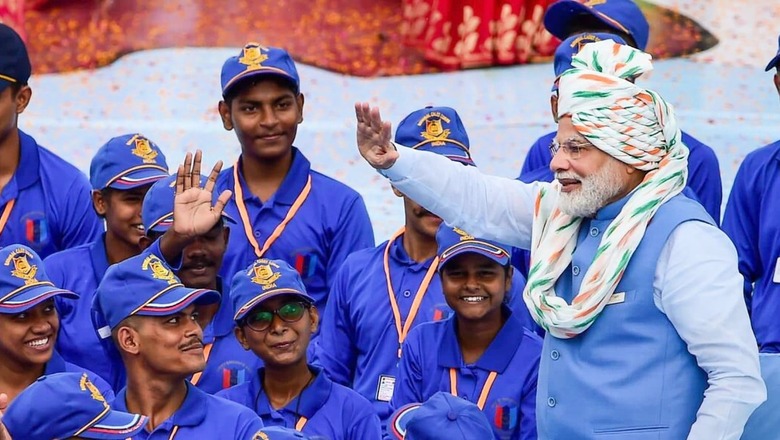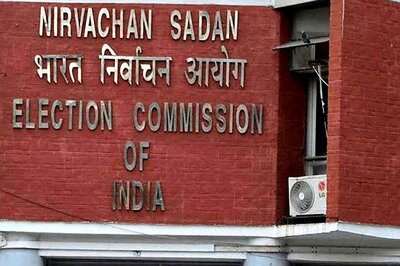
views
India’s Independence movement consisted of a long struggle of many decades, involving many great thinkers and activists from throughout the country and all walks of life. Yet, the Independence movement was also a continuation of a centuries long resistance to a hostile foreign rule that occurred at political, military, cultural and religious levels. India was never completely conquered, but only temporarily subdued and occupied as new leaders arose in every generation to continue the resistance and promote India’s self-rule.
Swami Vivekananda epitomised the spiritual and intellectual resistance to what was not only an attempt to control India politically and economically, but also to discredit it at a civilisational level. The British portrayed India not as a sophisticated civilisation whose influence was honoured throughout South, East and Central Asia for centuries, but rather as a poor, ignorant, superstitious and disunited culture to be cast aside as regressive in favour of an enlightened modern European rule.
Starting from 1893, Swami Vivekananda travelled worldwide spreading the message of India’s yoga and Vedanta traditions as the guiding knowledge for all humanity, capable of uniting religion and science, and all the peoples and countries of the world in the Vedic vision of One Self in all beings. This became the yogic spiritual foundation for India’s resistance to foreign rule.
The call for India’s Independence through the Congress party took shape through the determined labour of Lokmanya Tilak, who also emphasised a revival of India’s culture starting from the Vedas and the Bhagavad Gita to its great cultural festivals.
Sri Aurobindo’s in India’s Independence movement
Working with Tilak and also following the inspiration of Vivekananda, another extraordinary leader of India’s Independence movement arose. This was Sri Aurobindo Ghosh, who was a courageous freedom fighter as well as a Mahayogi and modern Rishi. That India’s Independence Day, 15 August, marks Sri Aurobindo’s birth anniversary is not just a coincidence but perhaps an indication of destiny as well. The 75th anniversary of Independence is also the 150th birth anniversary of Sri Aurobindo (15 August 1972 – 5 December 1950).
Sri Aurobindo promoted a determined and strategic activism against British rule on all levels, and many of the revolutionaries in the Independence movement followed his inspiration. Sri Aurobindo strived to awaken the Kshatriya/warrior spirit in India’s political activists, but also challenge the British at an intellectual and spiritual level and with his yogic philosophy for the development of a higher consciousness in humanity.
Sri Aurobindo, however, withdrew from political activism in 1910 to dedicate himself to the Supramental Yoga that he discovered, not only for India but for all humanity. Yet throughout his life, Sri Aurobindo continued to comment on the political situation in India and globally, providing his insight and advice for the country, though he never sought any position of power for himself, and remained focused on his yoga, its teachings and his disciples as primary.
Sri Aurobindo’s Knowledge and Influence
Sri Aurobindo presented not just the case for India’s political independence but also for its civilisational revival, which two movements he saw as interrelated. He linked this revival of India to the future evolution of humanity overall. This he structured in the background of an evolution of higher consciousness, not only science and technology. In this way he combined a yogic, scientific and dharmic vision relative to both the outer human life and an inner aspiration to the Divine.
As an incomparable and original thinker, poet, visionary, philosopher, psychologist and yogi, Sri Aurobindo’s writings and numerous books are vast and comprehensive in their scope. These include a veritable blueprint for India’s civilisational resurgence along with sharing its great teachings globally. His epic poem Savitri is the longest in the English language, as well as perhaps the most mystical, symbolic and yogic, holding the inner secrets of his teachings.
His understanding and presentation of Yoga, particularly through his Synthesis of Yoga brings yoga into the whole of life and action, with an integral understanding of human and cosmic existence, nature and the Divine. He proclaimed that “all life is yoga” and taught that yoga is not just for renunciation but also to help us perform all necessary actions in life in the highest possible manner. He saw yoga as a divinisation of the whole of human life.
Sri Aurobindo deeply understood and wrote upon India’s civilisation roots. This began with his uncovering the Secret of the Vedas, in which he revealed the yogic roots of the
Rig Veda, rejected the Aryan Invasion as a distortion, and revealed the Sanskrit foundation of Indo-European languages. His profound insights on the Upanishads and Vedanta became the basis for his own philosophy of Purna Advaita. He brought the characters of the Mahabharata and Ramayana to life in his descriptions, from Rama and Krishna to the kings, warriors and culture around them.
Sri Aurobindo and the Future of India
Sri Aurobindo stressed the importance of the Kshatriya Dharma in the Independence movement and running the country overall, much as Sri Krishna and Sri Rama represented it. He felt that India should be militarily strong as well as compassionate. He was staunchly opposed to communism but did not follow capitalism either. He had a vision of a powerful and prosperous India that honoured Lakshmi and Vishnu, Shiva and Shakti.
Sri Aurobindo revived the vision of India as World Guru, Vishvaguru, such as it was in ancient times when Hindu and Buddhist teachings were honored and followed throughout Asia. He charted out a new path to human unity through yoga, not simply through politics or religion. He gained many notable disciples in India and worldwide. He recognised and honoured the Mother, Mirra Alfassa, as carrying the power of his Supramental Yoga, who guided its ashram and founded its city of the future as Auroville.
As India projects its national vision into the 21st century, Sri Aurobindo remains as relevant now as during the Independence movement. Sri Aurobindo could perhaps be called the yogic father of the nation and the voice of India’s yogic civilisation for both the past and the future.
The New India today that is arising under Narendra Modi draws a profound inspiration and steady guidance from Sri Aurobindo and his numerous teachings that address the shaping of a nation, a new human being and a Divine manifestation. Sri Aurobindo’s New India is one of economic abundance, military strength, diplomatic astuteness, scientific advancement, and a yogic unfoldment of our highest potentials.
We see this New India emerging today 150 years after Sri Aurobindo’s birth and 75 years after India’s Independence in 1947. The New India still faces many challenges at both national and international levels, but now has a firm foundation to endure, unfold and prosper at both outer and inner levels.
The writer is the director of the American Institute of Vedic Studies and the author of more than 30 books on yoga and Vedic traditions. The views expressed are personal.
Read the Latest News and Breaking News here




















Comments
0 comment